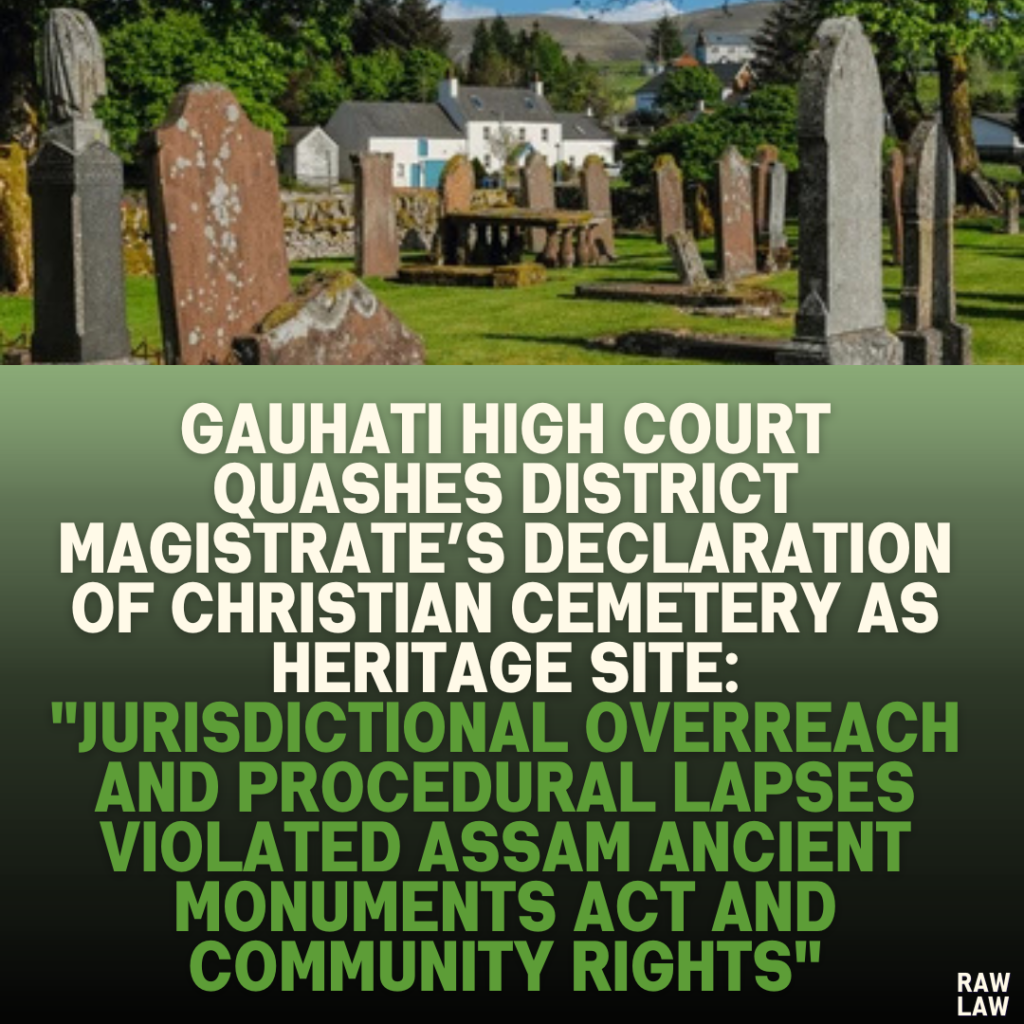1. Court’s Decision
The Gauhati High Court ruled that the orders issued by the District Magistrate, declaring the Christian Cemetery at Dag No. 183 as a heritage site, were null and void. The court found that the declaration lacked jurisdiction and was not compliant with the statutory procedures laid down under the Assam Ancient Monuments and Records Act, 1959, and the Rules of 1964. It emphasized that only the State Government, through the designated Superintendent of Archaeology, has the authority to declare a site as a heritage site or an ancient monument.
2. Facts of the Case
- Initial Declaration (2005):
The District Magistrate, Kamrup (M), issued an order on October 25, 2005, declaring the Christian Cemetery at Dag No. 183 a heritage site and prohibiting further burials. Additionally, adjacent land at Dag No. 181 was directed to remain as open space for community use. - Withdrawal and Reissuance (2006):
A complaint filed with the Assam Human Rights Commission prompted the District Magistrate to withdraw the declaration temporarily. However, after the Commission upheld the declaration, it was reissued on November 27, 2006. - Legal Challenge:
Representatives of the Christian community, arguing that the cemetery had been in use for centuries and was vital for the community, filed a writ petition challenging the legality of the District Magistrate’s orders.
3. Issues Identified by the Court
- Jurisdiction:
Did the District Magistrate have the legal authority to declare the cemetery as a heritage site? - Procedural Compliance:
Were the statutory procedures under the Assam Ancient Monuments and Records Act, 1959, followed before issuing the declaration?
4. Petitioner’s Arguments
- Lack of Jurisdiction:
The petitioners argued that the Assam Ancient Monuments and Records Act, 1959, vests the authority to declare heritage sites exclusively with the State Government, not with the District Magistrate. - Absence of Procedural Safeguards:
No notice was served to the affected Christian community before the declaration, and there was no investigation into the historical or archaeological significance of the cemetery as required under the law. - Cultural and Religious Significance:
The cemetery had been used for burials from time immemorial and was an essential part of the Christian community’s heritage.
5. Respondent’s Arguments
- Community Interest:
Local residents argued that the adjacent land (Dag No. 181) was designated as open space for public use and should not be encroached upon by the cemetery authorities. - Legitimacy of Declaration:
The respondents maintained that the declaration was in the public interest and aligned with protecting the cemetery’s heritage value. - Government’s Stand:
The State argued for remanding the matter to the appropriate authorities for reconsideration in accordance with the law.
6. Analysis of the Law
The court extensively examined the Assam Ancient Monuments and Records Act, 1959, and the Assam Ancient Monuments and Records Rules, 1964. Key observations include:
- Power to Declare Protected Monuments:
Under Section 3 of the 1959 Act, the State Government is empowered to declare a site as a protected monument. This declaration must follow:- A detailed investigation by the Superintendent of Archaeology into the antiquity and historical significance of the site.
- Public notification allowing objections.
- Final confirmation by the State Government.
- Definition of Ancient Monument:
A site must be at least 100 years old and of historical, archaeological, or artistic interest to qualify as an ancient monument. - Jurisdictional Overreach:
The District Magistrate has no authority under the 1959 Act to declare a site as a heritage site. The court noted that the declaration by the District Magistrate was ultra vires (beyond the powers of) the law.
7. Precedent Analysis
The court relied on Nazir Ahmed v. King Emperor (1936 AIR PC 253), which holds that when a statute prescribes a specific procedure for exercising a power, it must be strictly followed. Any deviation renders the action void.
8. Court’s Reasoning
- Lack of Procedural Compliance:
- No investigation into the antiquity or significance of the cemetery was conducted by the Superintendent of Archaeology.
- The declaration lacked a proper notification and opportunity for public objection.
- No Statutory Basis:
The Assam Ancient Monuments and Records Act, 1959, vests the power to declare protected monuments with the State Government, not the District Magistrate. - Violation of Rights:
The Christian community was not given notice or an opportunity to be heard, violating principles of natural justice.
9. Conclusion
- The High Court set aside the orders dated October 25, 2005, and November 27, 2006, declaring the cemetery a heritage site.
- It also quashed the Single Judge’s decision upholding the District Magistrate’s orders.
- The court clarified that the State Government is free to preserve the cemetery under the Assam Ancient Monuments and Records Act, 1959, or the Assam Heritage (Tangible) Protection, Preservation, Conservation and Maintenance Act, 2020, provided the proper legal process is followed.
10. Implications of the Judgment
- Administrative Clarity:
The judgment reinforces that only designated authorities can exercise powers under specific statutes. - Community Rights:
The ruling safeguards the cultural and religious rights of minority communities by ensuring due process in administrative decisions. - Precedent for Future Cases:
It underscores the importance of adhering to statutory procedures and provides a legal framework for declaring sites as heritage monuments. - Legal Safeguards:
The State Government must now strictly follow the procedural requirements for heritage site declarations, ensuring transparency and fairness.




Pingback: Jammu & Kashmir and Ladakh High Court Quashes Preventive Detention Order Under NDPS Act, Citing Non-Application of Mind, Procedural Violations, and Unexplained Delays, Reinforcing Constitutional Safeguards Against Arbitrary Detention - Raw Law